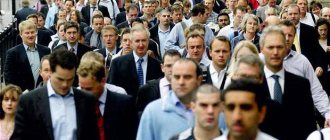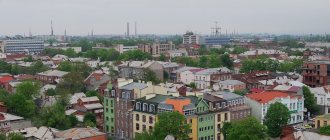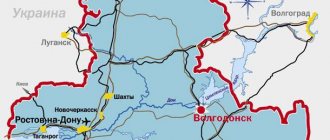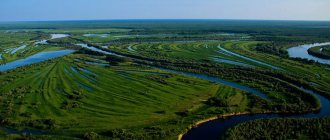Subject characteristics
The Oryol region is a subject of the Russian Federation. It is part of the Central Federal District and the Central Economic Region.
Geography The Oryol region is located in the central part of the Central Russian Upland in the forest-steppe zone and occupies 0.14% of the territory of the Russian Federation. The length from north to south is more than 150 km, from west to east – over 200 km. The area of the territory is 24.7 thousand km². The surface is a hilly plain, dissected by narrow steep river banks and ravines. The highest point of the region is 285.9 m above sea level in the Novoderevenkovsky district, the lowest is 120 m on the banks of the Sosna River along the border with the Lipetsk region. The main river is Oka (211 km within the Oryol region). The air temperature in the warm period of the year averages +19.3, in the cold winter period –8.6. In terms of precipitation, the region's territory belongs to the zone of moderate moisture, the average annual precipitation is 584 mm. The Oryol region borders in the north with Tula, in the east with Lipetsk, in the south with Kursk, in the west with Bryansk, and in the northwest with Kaluga regions. The total length of the borders is 840 km. The administrative center is the city of Orel. The permanent population is 787 thousand people. Population density is 31.9 people/km². The main part of the occupied area is agricultural land (2085.7 thousand hectares), of which 1662.7 thousand hectares (79.7%) is arable land. Forests are predominantly deciduous and mixed (oak, birch, pine, aspen, spruce, maple, linden, alder, larch, rowan), concentrated mainly in the north-west of the region and occupy 193.7 thousand hectares or 7.4% of the entire territory.
Soils The region is located in the zone of transitional soils from sod-podzolic to predominantly leached and podzolized chernozems. The region contains various types of soils - from light gray forest soils in the west to leached and typical black soils in the east and southeast. In terms of qualitative composition, arable and natural lands are represented quite diversely: leached chernozem makes up 12.8%; dark gray forest soils - 23.8%; podzolized chernozem - 29.7%; soddy-podzolic and light gray forest soils - 8.1%. And in total there are more than 240 soil varieties on arable land in the region.
Minerals Most of the area's minerals are not mined. There are iron ore reserves confined to the Kursk anomaly (large Novoyaltinskoye deposit in the Dmitrov region). There are reserves of brown coal, phosphorites, significant reserves of limestone, clay, sand, peat, and chalk. Celolite is mined near Khotynets. Uranium ore deposit in the southwest of the region.
Administrative-territorial division of the Oryol region There are 267 municipalities in the region: 3 urban districts of regional subordination (Orel, Livny, Mtsensk), 24 municipal districts, 17 urban settlements, 223 rural settlements and 2922 rural settlements.
Urban districts: Municipal entity "City of Orel" Municipal entity "City of Livny" Municipal entity "City of Mtsensk"
Municipal districts (people as of January 1, 2011): 1. Bolkhovsky district - 19,631 2. Verkhovsky district - 20,022 3. Glazunovsky district - 13,706 4. Dmitrovsky district - 13,624 5. Dolzhansky district - 12,530 6. Zalegoshchensky district – 16,510 7. Znamensky district – 5,835 8. Kolpnyansky district – 16,827 9. Korsakovsky district – 5,230 10. Krasnozorensky district – 7,677 11. Kromsky district – 23,040 12. Livensky district – 33,070 13. Maloarkhangelsk district – 12,221 14. Mtsensky district - 18,653 15. Novoderevenkovsky district - 12,632 16. Novosilsky district - 9,544 17. Oryol district - 67,327 18. Pokrovsky district - 16,396 19. Sverdlovsky district - 17,626 20. Soskovsky district - 7 372 21. Trosnyansky district - 11,337 22. Uritsky district - 19,981 23. Khotynetsky district - 11,809 24. Shablykinsky district - 7,716
Economy The economy has a pronounced industrial-agrarian character, the share of agriculture in GRP is 12.9% (2007), industry - 28.3% (2006). Specialization in agricultural sectors turned out to be problematic in the 1990s; the growth rate of GRP in the Oryol region during the years of economic recovery (1998-2004) was lower than the average for Russian regions - 142 and 151%, respectively. The production decline of the 1990s in the mechanical engineering and processing industries of the agro-industrial complex has not been overcome, so the volume of industrial production in the region in comparable prices in 2006 reached only 68% of the 1990 level. In the Oryol region there is a special regime for investment activity. A large international leasing project “Wheat 2000” has been implemented, which involves strengthening the urban-rural link through a network of joint productions. International corporations are also showing interest in the region. The production of Italian ceramic tiles (Velor CJSC) of the Kerama Marazzi Group has been established, and a soft drinks plant (Coca-Cola) is operating, serving the southern part of the Central Federal District relative to Moscow. Recently, a diamond production (ZAO Zolotoy Orel) and Frigorex-Eurasia LLC for the production of refrigeration equipment have been opened in Orel. The production base of local and light industry is being strengthened. There is an insulin plant - the only plant of this company in Russia.
Industry The main industries are mechanical engineering (30% of production volume), food industry (more than 25% with flour milling) and construction materials industry (13%). In addition to Orel, where most of the enterprises are concentrated, there are separate factories in Livny and Mtsensk, as well as in small towns. In Mtsensk there is an aluminum plant, which arose as a branch of the Moscow ZIL and works on non-ferrous scrap. More than 60% of the industrial output of the Oryol region comes from the city of Orel; the second and third places in terms of industrial potential are followed by Livny, where mechanical engineering and the food industry are developed, and Mtsensk, with its mechanical engineering and secondary aluminum plant. The remaining industrial ones mainly process agricultural products. Among them, Verkhovye stands out with a large dairy canning plant.
Agro-industrial complex The economic situation and ownership structure in the agro-industrial complex have changed. In the 1990s, the regional authorities tried to preserve agricultural enterprises and processing by uniting them into the Orlovskaya Niva agricultural holding. He performed external management functions for many unprofitable industries and ensured control of regional authorities in the industry. However, the holding did not solve the problem of modernizing the agro-industrial complex: by supporting the laggards, it bled potential leaders dry. As a result, Orlovskaya Niva broke up into a number of holdings grouped around viable processing enterprises. Thus, in the sugar industry, processing enterprises took control of beet-growing farms within their raw material zone of gravity. In addition, in recent years, the expansion of large companies in the agro-industrial complex has sharply increased, investments in pig and poultry farming, the sugar, canning industry and other agricultural processing sectors have increased.
Transport Important railways and highways pass through the region. The total length of public roads is 3209 km, of which 393 km are of federal importance. Main highways in the region: M2 "Crimea", E 105 (length within the region - 152 kilometers, through Mtsensk and Orel) P119 "Orel-Tambov" (151 km, through Livny and further to Yelets and Lipetsk) P120 "Orel-Efremov" (158 km, through Novosil) A141 “Orel-Vitebsk” (57 km, through Naryshkino, and further to Bryansk) P92 “Orel-Kaluga” (67 km, through Bolkhov, and further to Belev, Przemysl, Kaluga) A142, E 93 Trosnyansky district of the Oryol region - Zheleznogorsk of the Kursk region.
Railway The operational length of public railway tracks is 660.8 km, of which 168 km are electrified. The main line is a double-track electrified highway “Moscow-Kharkov-Simferopol” (136 km, through Mtsensk, Orel, Zmievka and Glazunovka). In addition to it, there are diesel single-track lines: “Orel-Elets” (130 km, through Zalegoshch, Verkhovye, Khomutovo and Krasnaya Zarya) with a branch to Livny, Dolgoe and Kolpna; historical “Riga-Eagle” (64 km, through Naryshkino and Khotynets and further to Bryansk); and “Orel-Dmitriev-Lgovsky” (83 km, via Kromy)
Pipelines and power lines The main pipelines pass through the territory of the Oryol region: oil pipelines “Druzhba-1”, “Druzhba-2” with a length of 293 km across the territory of the region; gas pipelines: Shebelinka-Belgorod-Kursk-Bryansk - 185 km, Tula-Shostka-Kyiv with a total length of 55.5 km in the region. Oryol is a large hub of oil product pipelines, including those exported to Belarus, Western Ukraine and the Baltic states, with branches passing through Bryansk and Kursk. The main power transmission line is 500 kV, connecting the Yeletskaya and Novobryanskaya substations, and feeding the region mainly from the Kursk and Smolensk nuclear power plants.
Regional authority Governor and Chairman of the Government of the Oryol region from September 14, 2022 - Andrey Evgenievich Klychkov. Chairman of the Oryol Regional Council of People's Deputies since December 16, 2011 - Leonid Semenovich Muzalevsky.
Source
Population of Orel: latest census data
The results of the latest census in Orel reflected the instability of the demographic situation in this city. Thus, during the period from 2002 to 2010, the total population of the city of Orel decreased by almost 18 thousand people. For a 300,000-tonne vehicle this is quite a lot.
The reason for urban depopulation is typical for most regions of modern Russia - mortality greatly exceeds birth rates. The average life expectancy of Oryol residents is 70 years. Moreover, between the female and male half of the city in this indicator there is a significant advantage in favor of women (76 and 64, respectively).
The only positive trend that is currently observed in the demography of the city is a slight positive migration increase in its population.
If we consider the population of Orel from the point of view of territorial distribution, then most people live in the Zavodskoy district of the city (every third Oryol resident lives here). The least number of residents was recorded in the Zheleznodorozhny district (only 20%).
The ethnic structure of this city is quite monolithic: about 97% of the total population are Russians. In addition to them, Orel also became the homeland for Ukrainians (1.1%), Armenians (0.4%), Belarusians (0.3%) and some other nationalities.
From Wikipedia - the free encyclopedia
| Timezone | MSK |
| Economy | |
| GRP | 230.7 [3] billion rubles. (2022) |
| • place | 62nd place |
| • per capita | 310.4 [6] thousand rubles. |
| Population | |
| Population | 724,686 [7] people. (2022) |
| Density | 29.4 people/km² |
| Digital IDs | |
| ISO 3166-2 code | RU-ORL |
| OKATO code | 54 |
| Code of the subject of the Russian Federation | 57 |
| Telephone code | +7 486 |
| Official site | |
| Educated - September 27, 1937. It borders on the regions: in the north with Tula, in the east with Lipetsk, in the south with Kursk, in the west with Bryansk, in the northwest with Kaluga. Source | |
The main demographic problems of Orel
The population of Orel, alas, is declining. And this is doubly offensive if we take into account the almost ideal natural and climatic conditions for life and the clean ecology of this settlement. The winter here is quite mild (by Russian standards, of course), the summer is not very hot. The surrounding area has beautiful nature. It would seem that the city should attract a huge number of people who want to live in it. But there is one big “but”.
During Soviet times, a number of industrial enterprises were created in Orel. Among them are rolling mills, glass factories, as well as factories for the production of machine tools and instruments. However, today all these enterprises are at the stage of closure. Therefore, the prospects for life in this city still remain very vague.
Orel is characterized by a high unemployment rate of 2.2 percent. In addition, in the near future several hundred more people working at one of the enterprises will remain unemployed. City authorities, of course, are trying to somehow solve this problem. In particular, the mayor's office, for its part, does its best to promote the development of private entrepreneurship in the city.
In addition to depopulation and unemployment, this subject of the Russian Federation is characterized by another acute demographic problem. This is the general “aging” of Oryol residents. Every year fewer and fewer babies are born in Orel, thus the age pyramid in the city is increasingly shifting towards older people. However, this problem is typical for most modern Russian (and European in general) settlements.
List of federal districts and subjects of the Russian Federation
Hello, dear colleague! To effectively participate in tenders (government procurement), it is necessary to narrow the search for information about ongoing tenders to a specific region or region.
Below I have provided data on the federal districts and their constituent entities of the Russian Federation. I hope this information will be useful to you, because... this is the main navigation tool for searching information in the Unified Information System (UIS).
Enterprises and educational institutions
Oryol is often called the “city of students.” The population, especially young people, can freely receive a prestigious education. Here, for every seventh resident there is one student. There are many government and commercial educational institutions in the regional center. The most famous of them: OSU named after I. S. Turgenev, OSAU, PSU, OGIET, Financial University under the Government of the Russian Federation and others.
The largest enterprises in the city are OJSC Orelstroy, CJSC Dormash, JSC Proton, NPJSC Nauchpribor, OJSC Severstalmetiz, LLC Plant named after. Medvedev" and others.
Oryol Region
CENTRAL Federal District of Russia. Oryol Region. Area 24.7 thousand sq. km. Formed on September 27, 1937. The administrative center of the Oryol region is the city of Orel
The Oryol region is a subject of the Russian Federation, part of the Central Federal District, located in the central part of the Central Russian Upland on the border of the steppe and forest-steppe zones. Main rivers: Oka with its tributaries.
The Oryol region is part of the Central Economic Region. The main advantages of the region are its good transport and geographical location, highly productive agriculture and fairly modern industry, which began to develop in the 70s. Disadvantages include the weakness of the budgetary base and the lack of large-scale production facilities - “points of growth.” Part of the territory of the Oryol region was exposed to radioactive emissions from the Chernobyl nuclear power plant.
Main industries: mechanical engineering (production of equipment for the textile, leather and footwear, glass, food industries, motor graders, forklifts, instruments, computers, watches, pumps); production of rolled steel, plastics; microbiological, light, food (sugar, meat) industries; production of building materials. Leading areas of agriculture: livestock breeding for meat and dairy, pig farming, poultry farming, horse breeding; growing grain crops and sugar beets.
The Oryol region was formed by a resolution of the Central Executive Committee of the USSR dated September 27, 1937 by separating the districts (counties) of the former Oryol province from those assigned to the Kursk, Western and Voronezh regions.
The Oryol region was awarded the Order of Lenin.
Orel population and its dynamics by year
As of the beginning of 2015, the city was home to 317 thousand inhabitants. Exactly a hundred years ago there were three times fewer Oryol residents. Until the early 90s, the city's population experienced stable growth. However, then demographers began to record its annual decline.
The historical maximum population of Orel was recorded in 1995 (344 thousand people). But during the period from 2000 to 2014, the number of city residents decreased by exactly 25 thousand.
Cities, Urban Districts and Municipal Districts of the Oryol Region
Cities of the Oryol region: Orel, Bolkhov, Dmitrovsk, Livny, Maloarkhangelsk, Mtsensk, Novosil.
Urban districts of the Oryol region: Urban district "City of Orel" Urban district "City of Livny" Urban district "City of Mtsensk"
Municipal districts of the Oryol region, Administrative center: Bolkhovsky - Bolkhov Verkhovsky - Verkhovye village Glazunovsky - Glazunovka village Dmitrovsky - Dmitrovsk-Orlovsky Dolzhansky - Dolgoe village Zalegoshchensky - Zalegoshch village Znamensky - village. Znamenskoye Kolpnyansky - town of Kolpny Korsakovsky - village. Korsakovo Krasnozorensky - village. Red Zarya Kromskaya - Kromy village Livensky - Livny Maloarkhangelsky - Maloarkhangelsk Mtsensk - Mtsensk Novoderevenkovsky - Khomutovo Novosilsky - Novosil Orlovsky - Orel Pokrovsky - Pokrovskoye Sverdlovsky - village. Zmievka Soskovsky - village. Soskovo Trosnyansky - Trosna Uritsky - Naryshkino Khotynetsky - Khotynets Shablykinsky - Shablykino
Source
CENTRAL federal district: Oryol region. Area 24.7 thousand sq. km. Formed on September 27, 1937. The administrative center of the federal district is the city of Orel
The Oryol region is a subject of the Russian Federation, part of the Central Federal District, located in the central part of the Central Russian Upland on the border of the steppe and forest-steppe zones. Main rivers: Oka with its tributaries.
The Oryol region is part of the Central Economic Region. The main advantages of the region are its good transport and geographical location, highly productive agriculture and fairly modern industry, which began to develop in the 70s. Disadvantages include the weakness of the budgetary base and the lack of large-scale production facilities - “points of growth.” Part of the territory of the Oryol region was exposed to radioactive emissions from the Chernobyl nuclear power plant. Main industries: mechanical engineering (production of equipment for the textile, leather and footwear, glass, food industries, motor graders, forklifts, instruments, computers, watches, pumps); production of rolled steel, plastics; microbiological, light, food (sugar, meat) industries; production of building materials. Leading areas of agriculture: livestock breeding for meat and dairy, pig farming, poultry farming, horse breeding; growing grain crops and sugar beets.
The Oryol region was formed by a resolution of the Central Executive Committee of the USSR dated September 27, 1937 by separating the districts (counties) of the former Oryol province from those assigned to the Kursk, Western and Voronezh regions.
The Oryol region was awarded the Order of Lenin.
Must-see sites
- Lenin Street. This is the main street of the city, and it is pedestrian, so you can walk along it calmly. While walking you can see very interesting buildings, beautiful architecture, and visit numerous cafes. There is a park adjacent to the street.
- Central park of the city of Orel. Harmony always reigns here. This place is loved not only by tourists, but also by the local residents of the city. There are always a lot of people in the park, but this does not spoil the atmosphere of calm and tranquility.
- Walk on a river bus. Anyone will be interested in looking at local species, especially since they will leave few people indifferent.
- Theater "Russian Style". The spectator is at the epicenter of the events, the hall has a capacity of 50 seats, so it is very difficult to get to the performance. It is best to book your tickets before arriving.
- Cathedral of the Archangel Michael (Assumption). The temple surprises with its beauty.
The city has several beaches, but due to active river transport, the water is polluted. It is not advisable to swim here, but you can sunbathe, because the beaches are well-maintained and have everything you need for relaxation. Oryol is a unique city, unlike others, a place worth visiting and relaxing in your soul.
The indigenous population of Orel tirelessly cares about its development and well-being.
Famous places in the city
Recreation places where locals and guests spend time are the City Park of Culture and Recreation, Lake Bright Life, and Alexander Bridge.
The multifunctional complex, which includes many shops, cafes, restaurants, and entertainment centers, has gained the greatest popularity among young people. Here are the largest nightclub in the Black Earth Region “Clocks”, karaoke bar “Night”, “Celebration Restaurant” and others. Other famous establishments in the city include the Labyrinth restaurant, the karaoke club Oz-bar, and the Na Privale cafe.










